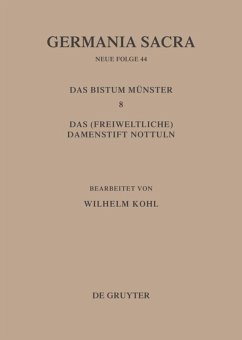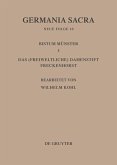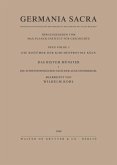In this volume, Wilhelm Kohl turns his attention to the ladies' secular abbey west of Münster. After covering the standard Germania Sacra aspects - archive, library, and memorials - Kohl focuses on the abbey's origins, its foundation as an early medieval cloister, as well as, its founding patrons. What follows is an exposition on the transformation of the cloister into a Kanonissenstift (canoness residence), leading to a history of the almost 1000 year old home up to its secularisation. Constitution, religious life, and above all, detailed lists of important names are further notable characteristics of this volume. With this, Wilhelm Kohl's volume not only is a fitting addition to the Germania Sacra volumes covering Saxonian Homes (GS NF 7: Gandersheim, GS NF 10: Freckenhorst, GS NF 21: Herzebrock, and GS NF 23: Liesborn), but also deepens the history of the Munster Diocese (thus far GS NF 3, 5, 10, 17, 23, 33, 37).
Mit dem vorliegenden Band widmet sich Wilhelm Kohl dem westlich von Münster liegenden Damenstift. Nach dem zum Aufbau der Germania Sacra gehörenden Punkten Archiv, Bibliothek und Denkmäler der Institution wendet sich der Autor der Frage der Gründung des frühmittelalterlichen Klosters und der Gründerfamilie zu. Dem schließt sich eine Ausführung über die Umwandlung des Klosters in ein Kanonissenstift an, der die Geschichte des fast tausendjährigen Stiftes bis zur Säkularisation folgt. Verfassung, religiöses Leben und vor allem ausführliche Personallisten sind ein weiteres Kennzeichen dieses Bandes. Damit fügt sich das Buch von Wilhelm Kohl einerseits den bereits erschienenen Bänden der Germania Sacra über frühmittelalterliche sächsische Kanonissenstifte ein (GS NF 7: Gandersheim, GS NF 10: Freckenhorst, GS NF 21: Herzebrock und GS NF 23: Liesborn), andererseits ergänzt und verdichtet es die Geschichte der Diözese Münster (bisher GS NF 3, 5, 10, 17, 23, 33, 37).
Mit dem vorliegenden Band widmet sich Wilhelm Kohl dem westlich von Münster liegenden Damenstift. Nach dem zum Aufbau der Germania Sacra gehörenden Punkten Archiv, Bibliothek und Denkmäler der Institution wendet sich der Autor der Frage der Gründung des frühmittelalterlichen Klosters und der Gründerfamilie zu. Dem schließt sich eine Ausführung über die Umwandlung des Klosters in ein Kanonissenstift an, der die Geschichte des fast tausendjährigen Stiftes bis zur Säkularisation folgt. Verfassung, religiöses Leben und vor allem ausführliche Personallisten sind ein weiteres Kennzeichen dieses Bandes. Damit fügt sich das Buch von Wilhelm Kohl einerseits den bereits erschienenen Bänden der Germania Sacra über frühmittelalterliche sächsische Kanonissenstifte ein (GS NF 7: Gandersheim, GS NF 10: Freckenhorst, GS NF 21: Herzebrock und GS NF 23: Liesborn), andererseits ergänzt und verdichtet es die Geschichte der Diözese Münster (bisher GS NF 3, 5, 10, 17, 23, 33, 37).








